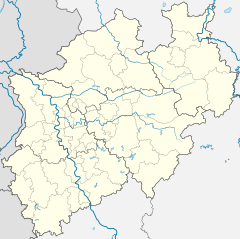
The DB Class 66 was a class of two Deutsche Bundesbahn (DB) locomotives designed for fast goods train and passenger train services on the main and branch lines of Deutsche Bundesbahn (DB), the national railway of the former West Germany.

The DBK Historic Railway is a preserved railway association in Crailsheim, Germany.

The Prussian Class P 8 of the Prussian state railways was a 4-6-0 steam locomotive built from 1906 to 1923 by the Berliner Maschinenbau and twelve other German factories. The design was created by Robert Garbe. It was intended as a successor to the Prussian P 6, which was regarded as unsatisfactory.

The German Railway History Company or DGEG is a society concerned with the history of the railways. The objectives of the society are:
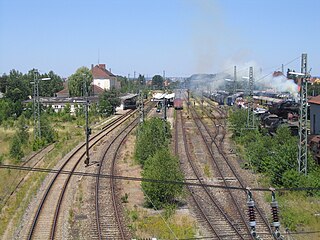
The Bavarian Railway Museum is a railway museum based in the old locomotive sheds at Nördlingen station in Bavaria, Germany. It is home to more than 100 original railway vehicles and has been located in the depot at Nördlingen since 1985.

The Nuremberg Transport Museum is based in Nuremberg, Germany, and consists of the Deutsche Bahn's own DB Museum and the Museum of Communications. It also has two satellite museums at Koblenz-Lützel and Halle. The Nuremberg Transport Museum is one of the oldest technical history museums in Europe.

The Darmstadt-Kranichstein Railway Museum a railway museum in the German city of Darmstadt. It is also the largest railway museum in the state of Hesse.

The German Steam Locomotive Museum or DDM is located at the foot of the famous Schiefe Ebene ramp on the Ludwig South-North Railway in Neuenmarkt, Upper Franconia. This region is in northern Bavaria, Germany. The DDM was founded in 1977.

The Class 80 tank engines were German standard locomotives (Einheitsloks) with the Deutsche Reichsbahn. They were intended to replace the aging, rickety state railway line engines performing shunting duties in their dotage at large stations.
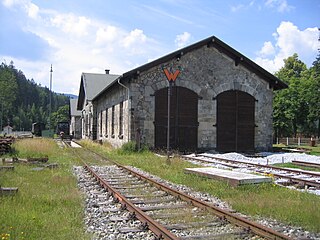
The Bavarian Localbahn Society, with its headquarters in Tegernsee, is a society that is concerned with the history of the railways in Bavaria. Localbahn means 'branch line' and is mainly used in southern Germany and Austria in lieu of the usual term Nebenbahn. The BLV's objectives are the operation of historic trains and the collection of historically valuable railway items from Bavaria.

The Neustadt/Weinstrasse Railway Museum is one of the two railway museums run by the German Railway History Company, or DGEG. It is located in the station at Neustadt an der Weinstraße. The other one is the Bochum Dahlhausen Railway Museum.

The Augsburg Railway Park is a railway museum in Augsburg on part of the former Augsburg locomotive shed owned by the Deutsche Bahn. Following reconstruction work, the park officially reopened on 13 April 2009. In the future, 29 historic locomotives from the EU member countries and also Switzerland will be exhibited in the roundhouse and on the turntable, the so-called Europa Roundhouse, which are protected historical buildings. In addition to the roundhouse there are also three historical steam locomotive halls with a workshop atmosphere and a historical smithy.

The Dampfbahn Fränkische Schweiz e. V. or DFS is a German museum railway operated by a registered society in Ebermannstadt, in a region of northern Bavaria, Germany, known as Franconian Switzerland.

The South German Railway Museum is a railway museum at Heilbronn in the state of Baden-Württemberg in southwestern Germany. It was founded in 1998.
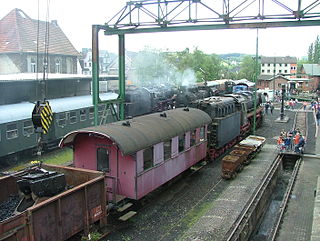
The Dieringhausen Railway Museum is a railway history museum in Dieringhausen in the district of Oberbergischer Kreis in North Rhine-Westphalia, Germany.

The German DRG Class 95 was a ten-coupled tank locomotive with a 2-10-2 wheel arrangement, which was procured by the Deutsche Reichsbahn in 1922 for hauling heavy goods trains on steep main lines. Because the development of this class was begun by the Prussian state railways, it was designated as the Prussian Class T 20.

The Saxon Railway Museum is located in Chemnitz, in the state of Saxony, eastern Germany. It is situated on the site of the former locomotive depot for goods train locomotives in the district Hilbersdorf.
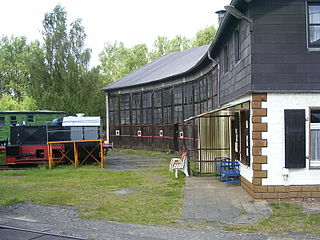
Bahnbetriebswerk Hermeskeil is a small, Prussian locomotive depot at Hermeskeil, in the state of Rhineland-Palatinate in Germany that dates from 1888. Until 1903, it was called a Maschinenstation.
The Prussian T 9 was a class of German steam locomotive which included several types of tank engine, all with six coupled wheels and two carrying wheels operated by the Prussian state railways.


